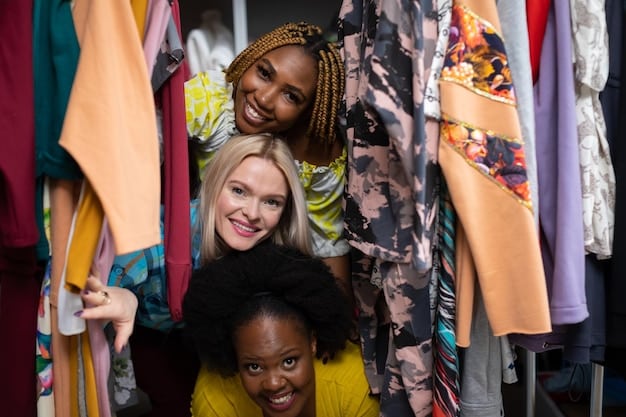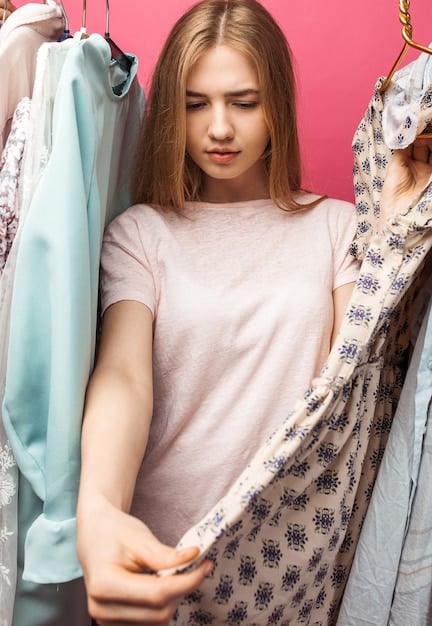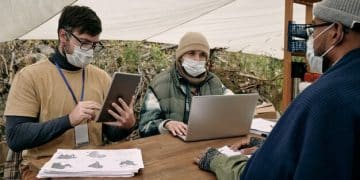Organize a Community Clothing Swap: Reduce Waste & Save Money

Organizing a community clothing swap is an excellent way to reduce textile waste, refresh wardrobes without spending money, and build community connections.
Ready to declutter your closet and give your clothes a new life? **Organizing a community clothing swap: Reduce waste and save money** while connecting with your neighbors and finding unique, pre-loved items.
Why Organize a Community Clothing Swap?
Organizing a community clothing swap offers a multitude of benefits, extending beyond just decluttering closets. It’s a sustainable and cost-effective way to engage with your community and promote environmentally friendly practices.
By hosting a clothing swap, you not only contribute to reducing textile waste but also provide a platform for people to refresh their wardrobes without spending a fortune.
Environmental Benefits
The fashion industry has a significant environmental impact. Hosting a clothing swap helps divert textiles from landfills, reducing pollution and conserving resources.
Community Building
A clothing swap is a great way to bring people together, foster connections, and build a stronger sense of community. It provides a relaxed and social environment for people to interact and share.
- Reduce textile waste and promote sustainability.
- Offer affordable access to clothing.
- Foster community spirit and social interaction.
- Provide a fun and engaging activity for all ages.

In summary, organizing a community clothing swap offers a powerful blend of environmental, economic, and social advantages, making it a worthy and rewarding endeavor for any community.
Planning Your Clothing Swap: Key Steps
Planning a successful clothing swap involves several crucial steps, from setting a date and location to promoting the event and organizing the clothing. Careful planning ensures a smooth and enjoyable experience for everyone involved.
Let’s break down the key steps to ensure your clothing swap is well-attended, organized, and contributes to a sustainable community event.
Setting the Date and Location
Choose a date that works well for your community, considering holidays and other local events. Select a location that is accessible, spacious, and can accommodate the expected number of participants.
Promoting the Event
Spread the word about your clothing swap through various channels, including social media, local community groups, and flyers. Highlight the benefits of participating and provide clear instructions on how to contribute.
- Announce the swap at least 4-6 weeks in advance.
- Utilize social media, local newsletters, and community boards for promotion.
- Create eye-catching flyers and posters with event details.
In conclusion, strategic planning is essential for the success of your clothing swap. By carefully addressing the key steps, you’ll set the stage for a well-attended and rewarding event.
Setting Rules and Guidelines
Establishing clear rules and guidelines for your clothing swap ensures fairness, transparency, and a positive experience for all participants. This includes defining what items are accepted and setting limits on the number of items each person can bring.
Here’s what to keep in mind to create clear and fair guidelines.
Accepted Items
Clearly define what items are accepted for the swap. Typically, this includes clean, gently used clothing, shoes, and accessories. Exclude items that are stained, damaged, or otherwise unsellable.
Setting Limits
Set a limit on the number of items each participant can bring to ensure that everyone has an equal opportunity to contribute and find new treasures. This also helps manage the volume of items at the event.
Without these guidelines, the swap could easily become disorganized, unfair, and less enjoyable for everyone involved.
Organizing and Displaying Clothing
The way you organize and display clothing at your swap can significantly impact the overall experience and encourage participation. Arranging items by size, type, and color makes it easier for attendees to find what they’re looking for.
Creating a visually appealing and easy-to-navigate display can draw more people in and make the event more engaging.

Sorting by Size
Separate clothing by size to help participants quickly locate items that fit. Use clear signage to indicate each size range, making it easy to browse and find suitable options.
Categorizing by Type
Group clothing by type, such as tops, bottoms, dresses, and outerwear. This helps attendees focus on specific categories and streamlines the browsing process.
- Use clothing racks, tables, and shelves to display items.
- Provide mirrors and changing rooms for participants to try on clothes.
- Ensure adequate lighting to showcase the items effectively.
Proper organization and appealing displays are vital for a successful and enjoyable clothing swap. By following these tips, you can create a welcoming and efficient environment that encourages participation.
Making the Clothing Swap Fun and Engaging
Adding fun and engaging elements to your clothing swap can boost attendance and create a positive atmosphere. Consider incorporating activities such as fashion shows, DIY workshops, or refreshments to enhance the experience.
These value-added components can make your clothing swap more than just an exchange of clothes; they can turn it into a memorable community event.
Fashion Shows
Organize a mini fashion show where participants can model their newly swapped outfits. This adds an element of entertainment and encourages creativity.
DIY Workshops
Offer DIY workshops on clothing alteration, upcycling, or mending. This provides valuable skills and promotes sustainable fashion practices.
- Offer complimentary snacks and beverages.
- Play upbeat music to create a lively atmosphere.
- Provide a photo booth with props for fun memories.
Adding fun and engaging elements can elevate your clothing swap from a simple exchange to a lively community event that people will look forward to attending.
Post-Swap Clean-Up and Donation
After the clothing swap, it’s essential to handle the leftover items responsibly. Organize a clean-up session and donate any remaining clothes to local charities or shelters.
Handling leftover items ethically and sustainably underscores the event’s commitment to reducing waste and supporting the community.
Clean-Up Session
Gather volunteers to help clean up the venue, sort the remaining items, and prepare them for donation. A well-organized clean-up ensures the space is left tidy and ready for future use.
Donation
Partner with local charities or shelters to donate the leftover clothing. This provides valuable resources to those in need and prevents textiles from ending up in landfills.
In conclusion, proper post-swap handling, including clean-up and donation, is vital for ensuring the event’s positive impact and reinforcing its commitment to sustainability and community support.
| Key Point | Brief Description |
|---|---|
| ♻️ Reduce Waste | Divert textiles from landfills by swapping clothes. |
| 🤝 Community Building | Connect with neighbors in a fun, social environment. |
| 💰 Save Money | Refresh your wardrobe without spending money. |
| 👗 Sustainable Fashion | Promote eco-friendly practices and reduce environmental impact. |
FAQ
▼
Bring clean, gently used clothing, shoes, and accessories that you no longer wear but are in good condition. Make sure items are free of stains, tears, and excessive wear.
▼
Use social media platforms, local community groups, flyers, and newsletters to spread the word. Highlight the benefits of participating and provide clear instructions on how to contribute.
▼
Clothing swaps reduce textile waste, offer affordable access to clothing, foster community spirit, and provide a fun and engaging activity. It promotes sustainability and strengthens community bonds.
▼
Organize clothing by size, type (tops, bottoms, dresses), and color. Use clear signage to indicate each category. Provide clothing racks, tables, mirrors, and changing rooms for participants.
▼
After the swap, organize a clean-up session and donate any remaining clothes to local charities, shelters, or non-profit organizations. This ensures the items benefit those in need and prevents waste.
Conclusion
Organizing a community clothing swap is a valuable way to promote sustainability, save money, and build stronger community connections. By following these guidelines, you can create a successful and enjoyable event that benefits both participants and the environment.





